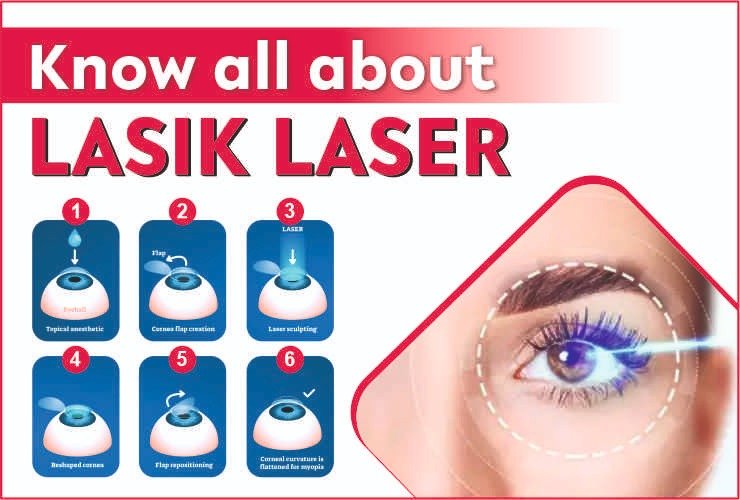Five Simple reasons that make us the undisputed best LASIK LASER Centre in Punjab.
- LASIK Technology: The Only super specialty in Ophthalmology with Robotic AI-aided Swiss Refractive suites approved by no less than the American FDA for its safety profile.
- LASIK Choices: The Only super specialty in Ophthalmology with all the latest LASIK technologies to choose from that best meet your vision needs.
- LASIK Surgeon: Surgeon Experience: The Only super specialty in Ophthalmology to have the world’s best Singapore National Eye Centre SNEC-trained refractive Eye surgeon.
- LASIK Hospital: The Only super specialty in Ophthalmology to extend its best patient care at the country’s premier chain of Hospitals – Max Healthcare.
- LASIK Customization: The Only super specialty in Ophthalmology that offers personalized treatment plans and customizes the procedure to meet your individual needs at unbeatable prices.

What is LASIK?
LASIK is a vision correction procedure to reduce or eliminate the use of eyeglasses. Refractive surgeons use excimer Lasers to reshape the Eye’s cornea to correct vision aberrations like near-sightedness, farsightedness, and Astigmatism. The procedure is times tested, used worldwide, and generally safe. However, LASIK cannot be done on all age groups. There are several eligibility criteria for LASIK
Who is eligible for LASIK?
Adults having stable eye power for at least a year with healthy eyes can go for LASIK. Additionally following specific criteria have to be met for eligibility & best results.
These include:
- Adults aged between 19 to 40
- Eye power within the prescribed range that can be corrected with LASIK
- One should not have any major eye diseases like Glaucoma or Cataracts
- Controlled Blood sugar levels are a prerequisite for LASIK (diabetes free)
- No other medical conditions, such as autoimmune diseases or consuming steroids
Once you meet this criterion, your eye surgeon will undertake a complete eye exam & tests like corneal topography and biometry and make the final decision about your LASIK eligibility and method.

What happens during a LASIK surgery?
LASIK, short form for Laser-Assisted In Situ Keratomileusis, is a Vision correction Laser Procedure to fix near-sightedness, farsightedness, and Astigmatism. A special laser is used to reshape the cornea’- the Eye’s outer transparent layer. This changes the light entry path into the Eye to focus on the retina correctly.
Step 1: Most of the time, the procedure starts with a mild sedative that numbs the Eye. The Surgeon will then use a blade-like tool called a microkeratome or a femtosecond laser to make a thin flap in the cornea. Next, the flap is folded to reveal the corneal tissue underneath.
Step 2: Next, the Surgeon will use an excimer laser to remove just the right amount of corneal tissue. The laser sends out pulses of ultraviolet light that turn tiny bits of tissue into vapor. This changes the shape of the cornea, which helps the patient see better.
Step 3: Once the laser reshaping is done, the flap is moved back into place and left there to heal. The whole process takes about 15 minutes for each Eye, and the patient can see better right away or within a day or two based on the LASIK technology used by the eye Surgeon.
Step 4: POST LASIK Recovery: Healing and getting better may take a few days to a few weeks, but most people can return to their everyday lives within a day or two.
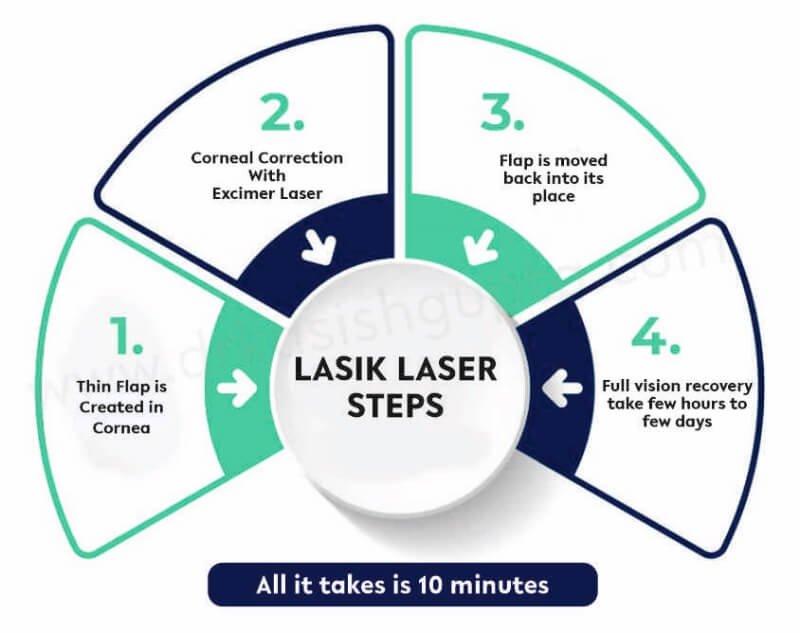
Types (techniques) of LASIK Eye surgery:
There are two main types of LASIK types One is Traditional ( Standard) LASIK, and the second is custom LASIK.
Traditional LASIK, also known as Standard LASIK, uses a one-size-fits-all technique to modify the shape of the cornea. Custom LASIK, on the other hand, uses advanced technology to create a unique treatment plan ( data points) for each patient based on their eyes
Blade-free or all-laser LASIK, wavefront-guided LASIK, and topography-guided LASIK are some of the newer types of LASIK.
The most popular method of LASIK till recently was traditional LASIK, which is also the cheapest. However, its risk factor is high, and healing takes considerably longer than the newer types of LASIK.
In Traditional or standard LASIK, an eye surgeon uses a blade-like tool called a microkeratome to cut a flap on top of the cornea. The flap is then carefully lifted from its position, and a special laser is used to change the shape of the tissue underneath the lifted flap. This type of LASIK is suitable for people with low to moderate levels of near-sightedness (myopia), farsightedness (hyperopia), and Astigmatism. They cost less but may be painful and relatively slow in healing.
Customized LASIK Technique
Custom LASIK also called wavefront-guided LASIK or wavefront-optimized LASIK uses cutting-edge technology to make a detailed map of the patient’s Eye. This data map is then used to render a treatment plan that is just right for the patient. This type of LASIK is more accurate than traditional LASIK and can fix higher levels of near-sightedness, farsightedness, Astigmatism, and other vision problems.
Blade-free or all-laser in LASIK
Here the flap in the cornea is made with a laser instead of a mechanical tool. This eliminates the risk of problems that come with using a microkeratome and is thought safer. Hence a twin Laser method is used first for Flap creation and second for corneal correction.
Topography-guided LASIK
Among the newer type of LASIK it uses advanced technology to make a detailed map of the patient’s cornea. This map is used to find and fix any irregularities in the shape of the cornea, which can cause blurred vision. This type of LASIK is suitable for people with keratoconus or an irregularly shaped cornea.
Which is the latest technology in LASIK LASER?
Objectively speaking, there is no single consensus on the best LASIK technology as of date. Several global brands and Ophthalmic tech solution companies claim to have developed the Latest LASIK technology with the best results. For your easy understanding and quick reference, we have enlisted the leading LASIK technology currently used in different parts of the world.
Ziemer’s Femtosecond laser-assisted LASIK
This technology uses a femtosecond laser (a laser that emits extremely short pulses, on the order of quadrillionths of a second) to create a precise, computer-controlled corneal flap before the excimer laser is used to reshape the cornea. This allows even more precise and accurate correction of vision problems and can reduce the risk of complications. Because of its best safety profile, Femto-second AI-assisted LASIK is approved by the top health regulator of the world – the American FDA. Patients with Femto LASIK experience instant vision improvement.
Contoura Vision LASIK
Contoura Vision LASIK technology uses Laser methods to create a topographic image of the Eye’s surface using enhanced mapping technology. This map then guides a surgeon on how to reshape the cornea, the transparent outer layer of the human Eye, to resolve near-sightedness, farsightedness, and astigmatism vision abnormalities. Contoura Vision LASIK comes with risks, just like any other surgery. However the procedure is generally considered safe and effective, and most patients see a significant improvement in their vision after it. Some of the risks of the system are dry eyes, glare, halos, and not enough or excessive correction.
SMILE LASIK Surgery
This is the abbreviated form for Small Incision Lenticule Extraction (SMILE). Smile is yet another recent addition to next-generation innovative and high-precision LASIK vision solutions; SMILE is a minimally invasive laser Flapless method. The curvature of your cornea is altered by SMILE surgery using surgically safe low-pulse lasers. This returns refraction to normal, restoring sharp vision. In addition, it reduces or eliminates the need for spectacles or contact lenses. SMILE is still in its early stages even though results so far have been excellent. It was approved in 2016 for myopia correction and in 2018 for astigmatism correction. After a relaxing SMILE surgical procedure, one can conduct almost all routine life activities and work duties without corrective lenses. As a result, your vision will undoubtedly improve. SMILE is inspired by Nobel Prize-winning physics technology and is considered a quantum leap in the refractive surgery ecosystem.
Alternatives Choices to LASIK LASER & IOL Implants
because of the thin cornea, eye topography, vision stability, and age, not all people can opt for LASIK LASER. Does it mean disappointment to those who want to get rid of eyeglasses? The answer is a big NO. We have several methods available to help you live without your spectacles or contact lenses or reduce your dependence on eyeglasses. Here are some of the most preferred LASIK choices that we cover at our hospital.

Phakic IOL implants
An eye surgeon implants an interocular lens IOL if your Eye’s natural lens no longer performs your vision requirements as per your needs. In phakic, a new artificial IOL lens is implanted into a cataract patient’s Eye without removing the Eye’s natural lens. Hence a lens on Lens configuration where the natural lens gives way to an artificial IOL lens to help the patient see well. The Phakic IOL gives clear vision at all distances, from close up to far away, without needing glasses or contacts. This lens is made of a unique material that allows the Eye’s natural way of focusing work. This helps make seeing more natural and comfortable. The Phakic IOL is a high-end option for cataract surgery. It is usually advised for individuals who need a lot of flexibility and clear vision.
RLE: Refractive Lens Exchange
Refractive Lens Exchange RLE is a few minutes of surgical procedures to improve vision for people over 45 who are tired of their reading glasses and their eyesight getting worse. RLE is popularly called the Lifestyle Lens because it lets people get back to doing many things they like. Refractive errors like nearsightedness, farsightedness, and presbyopia can be fixed with RLE. It is similar to cataract surgery, but instead of taking out the cloudy lens, a clear artificial intraocular lens (IOL) is placed in the patient’s Eye to let the patient see better. Often, RLE is done on people who are not good candidates for LASIK or PRK surgery or who have a high degree of refractive error.
ICL stands for “Implantable Collamer Lens,”
As an alternative to LASIK, the ICL procedure corrects refractive eye errors such as near-sightedness ( Myopia), farsightedness (Hyperopia), and Astigmatism. Unlike LASIK, ICL is reversible means that if you want, you can take out the artificial lens and put in a new one or let your natural Eye lens continue as before. On the flip side, though, its post-procedure recovery is slow and may take up to a few weeks. The ICL is a small, flexible lens inserted into the Eye through a small incision. It is positioned between the iris and the Eye’s natural lens and works by bending light to correct the refractive error. This type of surgery is an alternative to LASIK and PRK and does not require the removal of the cornea.
Photorefractive keratectomy PRK:
PRK Is yet another alternative for those unfit for LASIK and interested in getting rid of eyeglasses or reducing their use of spectacles. PRK is used to correct myopia (near-sightedness), hyperopia (farsightedness), and Astigmatism. PRK has several variants like EpiLASEK and transepithelial PRK or even some people have even started branding it as touchless LASIK.
PRK Advantages:
- No risk of flap-related complications.
- People with thin corneas or a history of eye injuries should consider this option.
- Recovery time is usually less than that of LASIK.
PRK’s disadvantages:
- The initial recovery period may be slightly more painful than with LASIK.
- With PRK, visual recovery is slower.
- PRK patients are more likely to experience dry eyes.
- A greater likelihood of haze following surgery
Note – your individual needs and the advice of your ophthalmologist will determine the best option for you after your clinical and diagnostic evaluation.
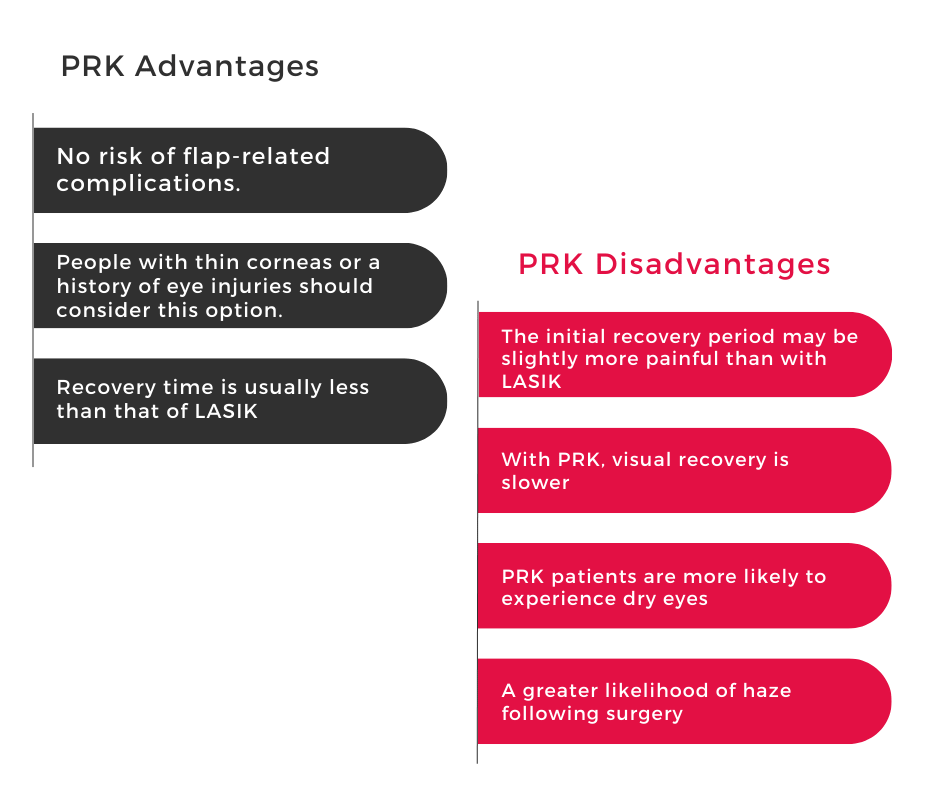
LASIK FAQ
Answers by Expert Eye Surgeon Dr. Kashish Gupta: Head Department of Eye ( ophthalmology) Max Hospital Bathinda, Punjab India
Q: How to reduce or get complete freedom from Eyeglasses?
Four popular ways to reduce or completely get rid of eyeglasses or spectacles are
- Corrective eye surgery such as LASIK
- Wearing contact lenses
- Undergoing vision therapy
- improving your diet and lifestyle to support the best eye health
several eye factors alongside eye specialists’ advice will help determine the best course of action for your individual needs.
Q: Is LASIK Eye surgery painful?
Most modern LASIK Laser technologies are painless. However, there is mild discomfort with the traditional LASIK done with a blade or Microkeratome. Current LASIK procedures take just a few minutes before LASER treatment numbing eye drops are applied to eliminate discomfort or pain. Some patients may feel a slight pressure or the impression that something is in their Eye, but this should not be uncomfortable. A few patients may suffer some discomfort or irritation in the eyes following the treatment, although this is usually treatable with over-the-counter painkillers. LASIK is regarded as a safe and successful Laser Vision correction with a high patient satisfaction rate.
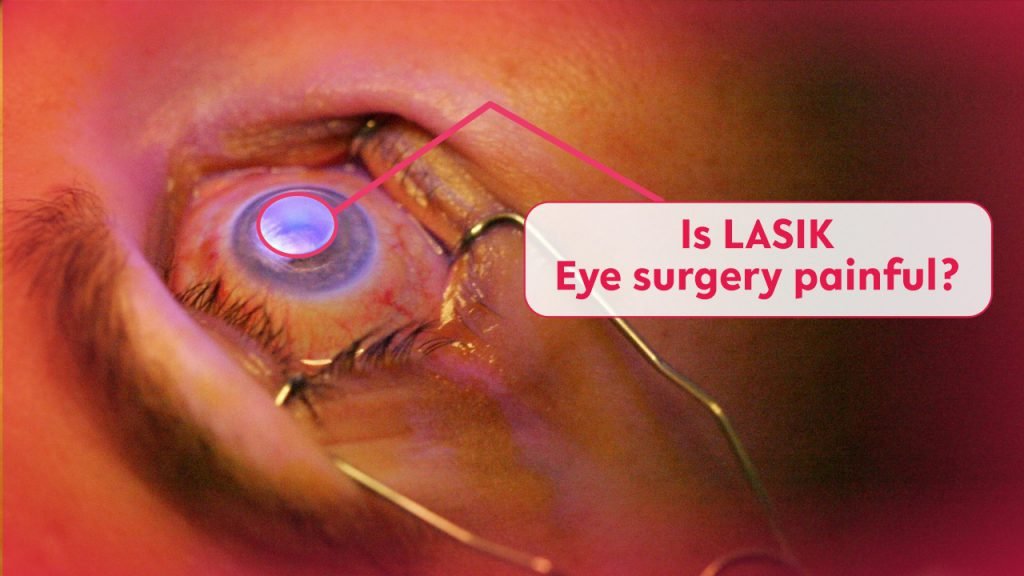
Q: Which LASIK type is the best?
LASIK types, as mentioned above, vary in their method, technology, safety, time, recovery, and cost. Which LASIK Suits you best depends on all these factors besides, of course, your preferences and expectations from LASIK
Q: IS LASIK Safe?
LAIK is a widely used procedure that works well to fix vision problems like nearsightedness, farsightedness, and Astigmatism. In addition, LASIK is quite a reliable and reasonably safe method to rectify refractive errors. Still, it’s essential to choose a reputable and experienced surgeon and the latest and safest technology, such as blade-free or all-laser LASIK and custom or wavefront-guided LASIK. This can help ensure you get the best possible result with the least risk of complications.
Q: What is the cost of LASIK eye surgery in India?
In India, LASIK eye surgery costs between Rs. 45,000 INR to Rs. 1,20,000 INR per Eye. The cost, however, depends directly on the Laser technology, Surgeon’s experience, safety features, and hospital facilities. Service standards and location. LASIK is a medical surgery, so surgeon and clinic expertise should always be prioritized before cost. Consult a skilled ophthalmologist or eye surgeon to decide if LASIK is right for you. You may choose to see our video here on LASIK costs in India
Q: Smile Vs CONOUTRA Vs FEMTO vs PRK; which is the best LASIK method?
As they say, no single fits suits all. More or less the same is true with LASIK technologies . In the innovative Laser ecosystem & IOL Implants, Tech solution giants in eye care like ZEISS, SCHWIND, Bausch & lamb are locked in tight competition to bring forth the best ophthalmic care Laser solutions platforms to. However, it is your eye needs, lifestyle, preferences, and expectations that you have from a specific Lasik eye surgery. Therefore, only you and Your eye doctor can determine the suitable technology that gives your expected results. A rule of thumb is that more choices in refractive vision corrections and the skill of LASIK surgeons should be preferred as that gives you more flexibility in choosing the best LASIK technology.
For a Quick reference, we have listed some of the latest refractive technologies that are most sought after these days in India.
- SMILE stands for Small Incision Lenticule Extraction. Smile is a LASIK procedure that uses a femtosecond laser to generate a corneal flap. The laser corrects vision by reshaping the cornea. Smile has a fast recovery, low pain, and a significantly high success ratio.
- CONTOURA topography-guided LASIK uses modern mapping technologies to adapt each patient’s treatment plan. This method can fix even severe Astigmatism.
- FEMTOSECOND LDV Z8 uses a femtosecond laser to create a thin corneal flap and reshape the cornea to correct visual impairments. Patients choose FEMTO because the femtosecond laser is more exact and predictable than the standard blade LASIK. In addition, the American FDA recommends it for its best safety profile.
- Transepithelial PRK: Trans-epithelial PRK, also known as “surface ablation and Epi-LASEK, is an old LASIK method that corrects near-sightedness, farsightedness, and Astigmatism. However, in recent times LASERS have substituted the chemicals and are now being re-branded as ‘Touchless LASIK’. Trans-epithelial PRK removes the cornea’s epithelium while altering the underlying tissue, unlike standard PRK, which uses Chemical surface ablation.
Q: Can I do LASIK Eye surgery?
Not all people are eligible for LASIK. Several factors determine your LASIK suitability. First, LASIK-interested people must undergo a thorough eye exam and talk to a qualified ophthalmologist to find out which LASIK type or LASIK Alternative is best for them.
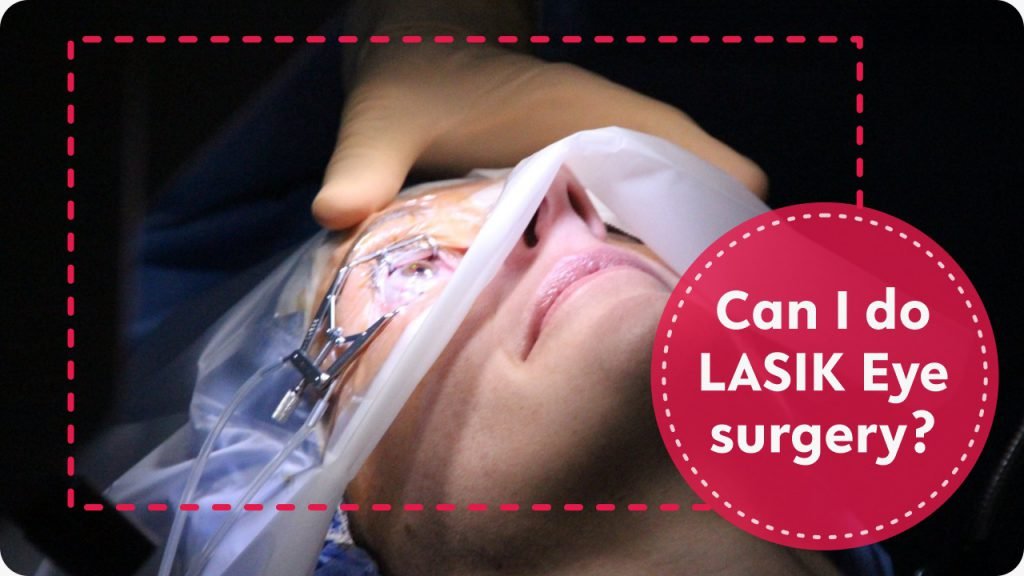
Q: How to find the best eye surgeon for my LASIK eye surgery?
- Simple steps will help you find the best LASIK eye surgeon near you.
- Be informed and know what LASIK is, what different LASIK technologies are available, and their comparisons and costs. (Watch this video to understand all about LASIK )
- Research the web & and you will get a list of the best skilled, experienced, and successful LASIK surgeons
- Because LASIK deals with your vision, don’t compromise on the quality of hospital services.
- Patient Reviews: Find patient reviews online to learn about their experiences.
- Consultation: Visit the best Surgeon you have shortlisted and get fully satisfied with what they have to offer
- Don’t forget to check the credentials, reputations, and registration of the doctor
- The Rule of thumb is the best Hospital in your city will have the best eye surgeons for LASIK
Q: Is Phakic Intraocular Lenses (IOLs) and ICL Implantable Contact Lens the same?
No, they are not entirely the same, as there is a difference in the lens implant procedure. IOLs are inserted directly into the Eye in the Phakic method, often before the standard lens. Correcting near-sightedness, farsightedness, and Astigmatism. On the contrary Thin, flexible ICLs are inserted between the iris and the natural lens. They correct moderate-to-severe near-sightedness. Phakic IOLs and ICLs are alternatives to LASIK and PRK, although their implantation and placement differ.
Watch our easy-to-understand video that will guide you in finding the best eye surgeon.

